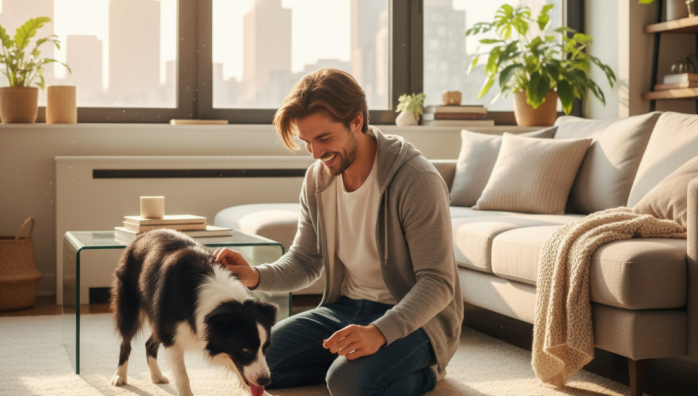Apartment Exercise Routines for Energetic Dogs
by admin in Pet Care Basics 26 - Last Update November 21, 2025

When I first brought my rescue, a ridiculously energetic Kelpie mix named Milo, into my 700-square-foot apartment, I had a moment of sheer panic. I thought, \'What have I done?\' The image of him bouncing off the walls was very, very real. A yard seemed like a non-negotiable, but life had other plans. It forced me to get creative, and honestly, it deepened our bond in ways I never expected. It turns out, you don\'t need a huge space to have a happy, well-exercised dog; you just need a better plan.
Thinking beyond the walk
The biggest \'aha\' moment for me was realizing that physical exhaustion is only half the battle. High-energy breeds are often incredibly intelligent. They need mental exercise just as much, if not more, than physical running. A tired mind leads to a calm dog. For us, this meant shifting focus from just \'more walks\' to \'smarter playtime\'.
Mental workouts are your secret weapon
These are the activities that saved my sanity and my furniture. They require very little space but a lot of brainpower from your dog.
- Nose work games: I started hiding high-value treats around the apartment. At first, I made it easy, and as Milo got better, I\'d hide them in trickier spots—under a rug, inside a box. It\'s incredible to watch his focus. This simple \'find it\' game can tire him out more than a 20-minute run.
- Puzzle toys and feeders: Instead of feeding him from a bowl, I started using puzzle feeders for every meal. It turns a 30-second gulp-fest into a 15-minute problem-solving session. I rotate between a few different types to keep it challenging.
- Learning new tricks: We have a 10-minute training session every day. We work on new commands or chain together old ones. This focused interaction is a powerful mental exercise and reinforces our bond.
Structuring indoor physical activity
Of course, they still need to move their bodies. Unstructured, wild running isn\'t feasible or safe indoors. The key is controlled, focused physical activity that won\'t have you patching drywall or apologizing to your downstairs neighbors.
Controlled indoor games
Before starting any new high-impact routine, I had a quick chat with my vet to make sure Milo\'s joints were up for it, which I\'d recommend for any dog owner.
- Tug-of-war with rules: Tug is a fantastic indoor game, but I had to establish clear rules. We have a specific \'tug\' toy, and I taught him a \'drop it\' command. The game always ends when I say so, which keeps it from escalating into over-arousal.
- Hallway fetch: We don\'t have a lot of space, but our hallway is perfect for short-distance fetch with a soft ball. It’s more about the repetitive \'go and bring back\' command than it is about a full-out sprint.
- Flirt pole: This is basically a cat toy for dogs, and it\'s a game-changer. It allows you to engage your dog in a vigorous game of chase in a relatively small area. It\'s great for practicing impulse control, too.
Making the most of the outdoors
Living in an apartment means outdoor time is precious. I learned to make every trip outside an opportunity for quality exercise, not just a quick potty break. We explore different routes to provide new smells and scenery, practice \'urban agility\' by having him jump on and off benches (where permitted and safe), and use long lines in parks to allow for a good run without being fully off-leash. It\'s about the quality of the outing, not just the duration.
Living with a high-energy dog in a small space isn\'t a limitation; it\'s an opportunity. It taught me to be a more engaged, creative, and thoughtful owner. Your dog doesn\'t care about square footage—they just care about spending quality, engaging time with you.











